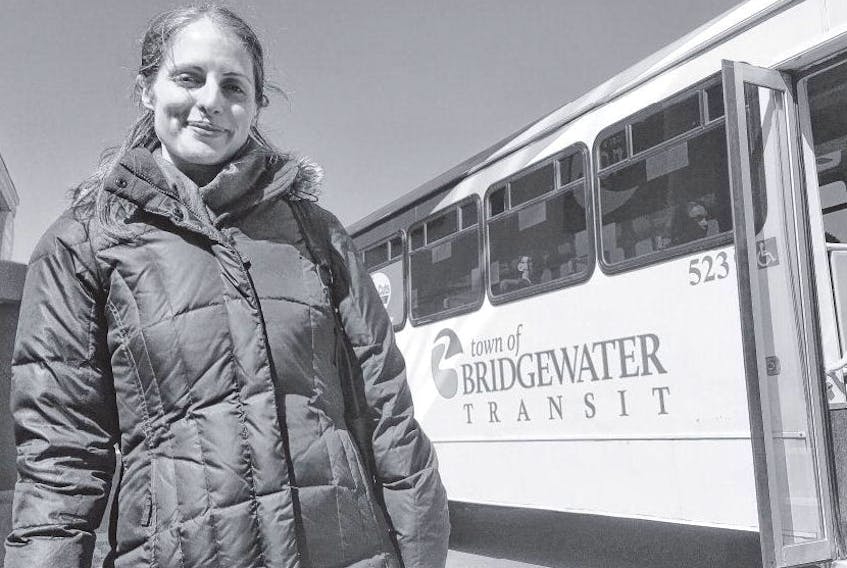Ellen Johnson can spend a couple days mapping out a walking route to the grocery store or her doctors’ office.
Busy intersections are particularly dangerous for the Bridgewater resident because she has trouble seeing the traffic lights and the majority of them aren’t equipped with sound signals that let her know when it’s safe or no longer safe to cross.
Johnson is legally blind and copes with stargardt macular degeneration, a genetic eye disorder that causes progressive vision loss. Because of her disability she can’t drive.
Life has become a little simpler for Johnson since the town launched a bus route 16 months ago. The occupational therapist can now rely on the bus to get groceries, hitch a ride back home from work and travelling with her son to his swimming and karate lessons are a little less exhausting.
She’s pleased to know that the town’s pilot project will be extended for another year, running until March 31, 2019.
Of the $253,000 operational budget, $200,000 is covered by a grant, while the service is expected to generate $41,000 in revenue. The town will cover the remaining portion. Johnson typically uses the service three times a week. It’s a service vital to the community and beyond, she says.
“It provides choice,” said Johnson. “There’s an expectation that you can get where you need to go without public transit. That’s not the case for a lot of people. Not having access to reliable transportation can be isolating. It’s inconvenient and it’s frustrating. You don’t want to be relying on people, you want to be independent.”
Only one 32-seat bus services the town. A full run usually takes an hour to complete but it fills an important void for Johnson but for others as well, including seniors and low income earners who don’t have access to reliable transportation. The other benefits are a little harder to measure.
“It’s the trickle down effect, allowing people to go where they need to go and you see, too, that their social needs are being met at the same time,” said Johnson. “Here people talk to each other and the bus driver talks to you.”
Mayor David Mitchell agrees. He also knows that no transit system makes a profit. He says it’s about getting the larger community to buy into a public transportation system. That takes time.Yarmouth is in a similar position, now in its second year operating a public transportation system.
“The goal is not for this to somehow magically make money, that won’t happen,” said Mitchell. “But there has to be a point where numbers of ridership and numbers for cost justify it. We’re not there now to make it a permanent service. But we’re on a really good trajectory to steadily increase ridership to where we are more comfortable.”
Currently Bridgewater Transit’s average daily ridership is 60 people, up from 43 riders. The target set for this year is an average of 88 riders per day.
“It’s easy to say, ‘Well, I have two cars and I have a nice house so why do we need a bus?’ It’s just making sure that people who need it have access to it. During the election I sat in someone’s living room and she basically told me that every dollar she spends on cab fare is a dollar she could put food on the table. So now that the bus is two dollars each way and cab fare is $8 each way, that’s $12 dollars she can spend buying nutritious food.
Mitchell has seen signs of progress. The town decided to waive the bus fee for March break and the community responded, packing the bus on several occasions, said Mitchell.
“So that’s 32 people in the seats and another 16 people standing. It shows that there is a desire to use the bus and a need to use the bus. We have to find consistency and prove that we’re not just here to do this for a year, or a year and a half.”









